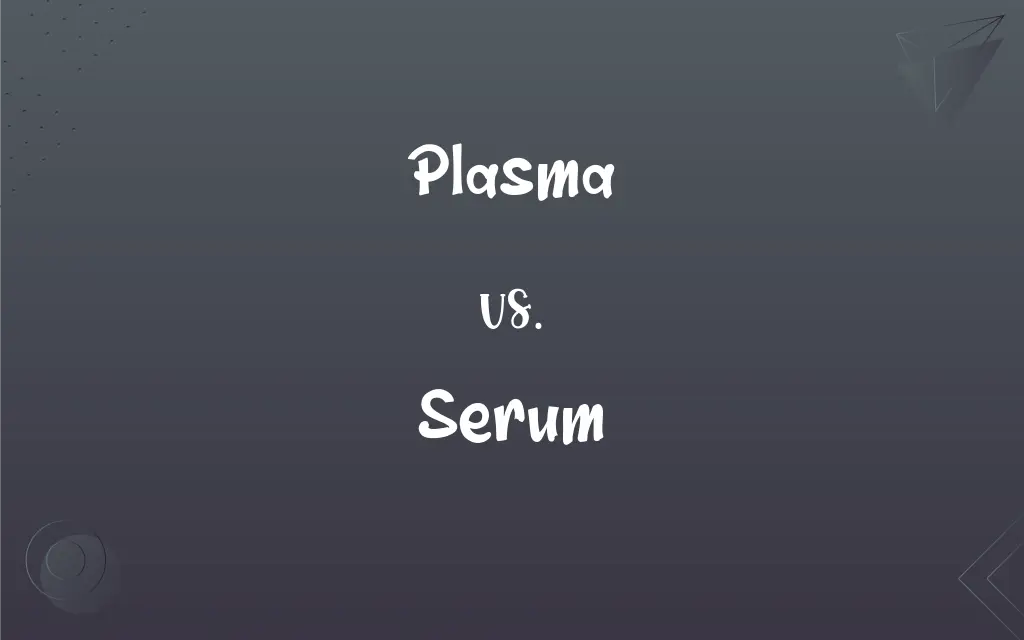Plasma vs. Serum: What's the Difference?
Edited by Aimie Carlson || By Harlon Moss || Updated on October 17, 2023
Plasma is the liquid component of blood with clotting factors, while serum is the liquid portion of blood after clotting, lacking these factors.

Key Differences
Plasma is the yellowish liquid component of blood that constitutes about 55% of its volume. It contains water, electrolytes, proteins, hormones, and waste products. Serum, on the other hand, is the clear liquid that remains after the blood has clotted, thus being devoid of clotting factors found in plasma.
When blood is drawn and anticoagulants are added, it prevents the blood from clotting, resulting in plasma upon centrifugation. Serum, conversely, is obtained by allowing the blood to clot first and then subjecting it to centrifugation, separating it from the clot.
Both plasma and serum are used for diagnostic purposes, though their applications vary based on their composition. Since plasma contains clotting factors, it's often used in tests that evaluate coagulation pathways. Serum, being free of clotting factors, is typically used in serological tests and to measure certain enzyme levels.
From a clinical perspective, understanding the distinction between plasma and serum is essential. While both provide valuable information about a patient's health status, the absence or presence of clotting factors can influence the outcomes and interpretations of various laboratory tests.
Comparison Chart
Definition
Liquid component of blood with clotting factors.
Liquid portion of blood after clotting.
ADVERTISEMENT
Contains
Clotting factors, proteins, electrolytes, hormones.
Lacks clotting factors.
Obtained from
Blood with anticoagulants, upon centrifugation.
Clotted blood, upon centrifugation.
Usage in Tests
Evaluates coagulation pathways.
Serological tests, certain enzyme measurements.
Color
Yellowish due to proteins.
Clear, since it's devoid of clotting factors.
Plasma and Serum Definitions
Plasma
The clear, extracellular fluid in body tissues.
In severe burns, patients may lose significant amounts of plasma, requiring fluid resuscitation.
ADVERTISEMENT
Serum
A product derived from blood used to provide immunity against diseases.
The patient received a tetanus serum after stepping on a rusty nail.
Plasma
A state of matter where atoms are ionized and electrons move freely.
The sun is composed largely of plasma, emitting light and heat.
Serum
The clear, yellowish fluid that remains from blood plasma after clotting.
The lab technician extracted the serum to test for specific antibodies.
Plasma
A type of display screen used in televisions and monitors.
The plasma TV provided sharper images than older models.
Serum
A skincare product with a high concentration of active ingredients.
She applied the serum every night for better skin hydration.
Plasma
The liquid component of blood, containing water, proteins, and other solutes.
The donated blood was separated to retrieve the plasma for a patient in need.
Serum
The liquid left after the removal of cells and fibrin clot.
Doctors sent the serum for diagnostic testing to identify potential infections.
Plasma
A medium or substance through which signals, particles, or currents pass.
Scientists used a plasma medium to study particle interactions.
Serum
The watery portion of an animal fluid with its particles in solution.
The snake's venom serum can be dangerous if introduced into the bloodstream.
Plasma
The clear, yellowish fluid portion of blood, lymph, or intramuscular fluid in which cells are suspended. It differs from serum in that it contains fibrin and other soluble clotting elements.
Serum
The clear yellowish fluid obtained upon separating whole blood into its solid and liquid components after it has been allowed to clot. Also called blood serum.
Plasma
Blood plasma, especially when sterilized and depleted of cells for transfusion.
Serum
Blood serum from the tissues of immunized animals, containing antibodies and used to transfer immunity to another individual.
FAQs
Can plasma clot?
Yes, plasma can clot due to the presence of clotting factors.
Is serum used in coagulation tests?
No, serum lacks clotting factors, so plasma is used for such tests.
How does serum differ from plasma?
Serum is the liquid that remains after blood clots, lacking the clotting factors present in plasma.
Is serum in skincare the same as blood serum?
No, while both are called "serum," in skincare it refers to a product with concentrated active ingredients.
Can serum be frozen for future use?
Yes, serum can be frozen for extended storage and future testing.
How is serum used in immunology?
Serum can be tested for the presence of antibodies, indicating immune responses to pathogens or vaccines.
Why is serum clear?
Serum is clear because it's free from the cells and clotting factors that are present in plasma.
How is plasma obtained in the lab?
Plasma is obtained by centrifuging blood that's been treated with anticoagulants.
Is plasma only found in blood?
While commonly associated with blood, plasma also refers to ionized gases and other contexts outside of biology.
What is plasma?
Plasma is the liquid component of blood, containing water, proteins, electrolytes, and other solutes.
What color is plasma?
Plasma is typically yellowish due to the proteins it contains.
Does plasma contain white and red blood cells?
No, plasma is the cell-free component of blood.
Why might a doctor request a serum test?
Serum tests can measure enzyme levels, antibodies, and other factors indicative of health conditions.
Can both plasma and serum be used for the same tests?
No, the choice between plasma and serum depends on the test's specific requirements.
Why is plasma important for the body?
Plasma transports nutrients, hormones, and waste products, playing a key role in homeostasis.
Can diseases affect the composition of plasma and serum?
Yes, various diseases can alter the levels of proteins and other solutes in both plasma and serum.
What might affect the appearance of serum?
Diet, hydration, and certain medical conditions can influence serum's appearance.
Can serum provide information about infections?
Yes, serum can contain antibodies which indicate exposure to infections.
What's the significance of plasma donations?
Plasma donations can be used for various medical treatments and to make life-saving therapies.
What is the main protein found in plasma?
Albumin is a major protein found in plasma.
About Author
Written by
Harlon MossHarlon is a seasoned quality moderator and accomplished content writer for Difference Wiki. An alumnus of the prestigious University of California, he earned his degree in Computer Science. Leveraging his academic background, Harlon brings a meticulous and informed perspective to his work, ensuring content accuracy and excellence.
Edited by
Aimie CarlsonAimie Carlson, holding a master's degree in English literature, is a fervent English language enthusiast. She lends her writing talents to Difference Wiki, a prominent website that specializes in comparisons, offering readers insightful analyses that both captivate and inform.
































































